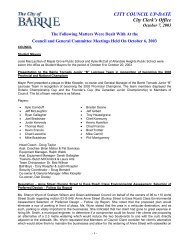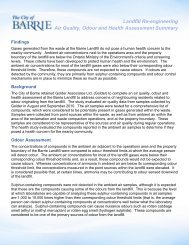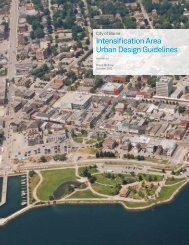economic development strategy and action plan 2009 ... - City of Barrie
economic development strategy and action plan 2009 ... - City of Barrie
economic development strategy and action plan 2009 ... - City of Barrie
Create successful ePaper yourself
Turn your PDF publications into a flip-book with our unique Google optimized e-Paper software.
• Pr<strong>of</strong>essional, Scientific + Business Services<br />
o Other pr<strong>of</strong>essional, scientific <strong>and</strong> technical services<br />
o Accounting, tax preparation, bookkeeping <strong>and</strong> payroll services<br />
• Health Care <strong>and</strong> Social Assistance<br />
o Out-patient care centres<br />
o Nursing <strong>and</strong> residential care facilities<br />
o Individual <strong>and</strong> family services<br />
o Hospitals<br />
An important consideration in determining the city’s target sector focus is the projected growth <strong>of</strong> these<br />
sectors at both the provincial <strong>and</strong> local level as well as emerging trends that will shape the industry in the<br />
future. A further consideration is the need to identify where <strong>economic</strong> <strong>development</strong> activities should<br />
involve investment attr<strong>action</strong>, workforce attr<strong>action</strong>, or retention <strong>and</strong> expansion efforts to ensure their long<br />
term sustainability <strong>and</strong> viability in the city.<br />
3.3.1 Transportation + Warehousing // Wholesale Trade Sectors<br />
The transportation <strong>and</strong> warehousing sector in Ontario accounted for 3.8% <strong>of</strong> the Province’s economy in<br />
2008, with activities such as the shipping <strong>and</strong> storage <strong>of</strong> consumer goods, manufactured products, <strong>and</strong><br />
commodities. Despite the <strong>economic</strong> downturn, the sector has been largely unaffected. While the sector<br />
has suffered some setbacks through 2008 <strong>and</strong> <strong>2009</strong>, including a decrease in GDP (-2.8% from Q42008 to<br />
Q1<strong>2009</strong>) <strong>and</strong> a decrease in workforce (1.3% from June 2008 to June <strong>2009</strong>), it has maintained a relatively<br />
stable share <strong>of</strong> the province’s total output (3.7% <strong>of</strong> Ontario’s GDP in Q1<strong>2009</strong>). Overall the industry is<br />
seen as being comparatively stable, but as its fortunes are largely tied to the province’s manufacturing<br />
<strong>and</strong> trade activity, recovery depends on the performances <strong>of</strong> other related sectors.<br />
However, the sector is expected to rebound into 2010. The largest factors influencing this rebound should<br />
be a stabilizing manufacturing sector, increased wholesale trade, <strong>and</strong> increased infrastructure spending<br />
spillovers 14 .<br />
Like the transportation <strong>and</strong> warehousing sector, the performance <strong>of</strong> the wholesale trade sector in Ontario<br />
is impacted by the downturn in the manufacturing sector. In 2008, Wholesale Trade industries accounted<br />
for 6.3% <strong>of</strong> the provinces GDP, which has decreased to 5.7% at the first quarter <strong>of</strong> <strong>2009</strong> largely based on<br />
decreased production in the manufacturing sector, a slower residential construction market, <strong>and</strong><br />
lacklustre retail sales activity. Overall, wholesale trade sales decreased by 0.6% from 2007 to 2008, an<br />
indicator that actually appears to be rising in the early part <strong>of</strong> <strong>2009</strong> 15 . Much <strong>of</strong> this recovery is tied to<br />
increases in the automotive products <strong>and</strong> food, beverages <strong>and</strong> tobacco subsectors 16 .<br />
With economists projecting a slow recovery in the manufacturing sector, it is reasonable to assume that<br />
growth in the wholesale trade sector could also be slow. However, the decreases in automotive assembly<br />
<strong>and</strong> component manufacturing output are starting to level <strong>of</strong>f, <strong>and</strong> retail sales are starting to return to prerecession<br />
levels. As well, residential housing construction in Canada is expected to rebound over the<br />
short term, with housing starts in Ontario expected to show growth again in 2010 17 . Also <strong>of</strong> note is the<br />
potential for <strong>economic</strong> spill-over based on the infrastructure stimulus. While directly affecting activity in the<br />
construction <strong>and</strong> manufacturing sectors, wholesale trade should receive a boost as well based on<br />
increased purchasing <strong>and</strong> service requirements.<br />
14 Scotiabank Group, Provincial Trends, <strong>2009</strong><br />
15 Ontario Ministry <strong>of</strong> Finance, Economic Accounts, July <strong>2009</strong><br />
16 Statistics Canada, The Daily - Wholesale Trade, August 20, <strong>2009</strong><br />
17 TD Economics, Provincial Economic Forecast, July 16, <strong>2009</strong><br />
<strong>City</strong> <strong>of</strong> <strong>Barrie</strong> Economic Development Strategy 41 | P age


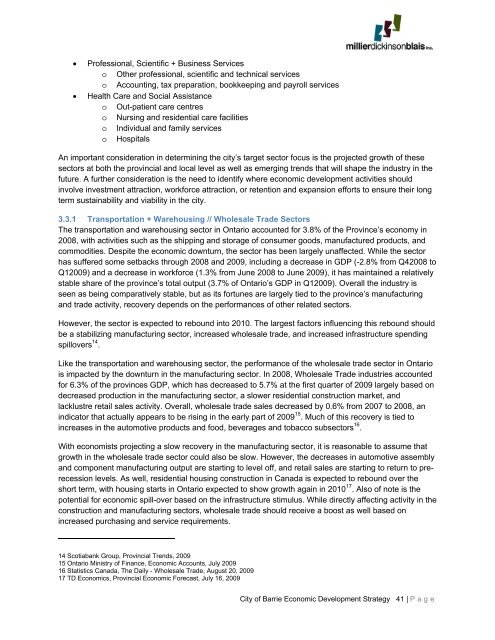

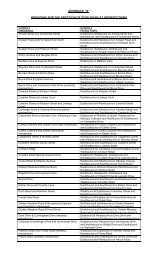


![Water Specification [DOC] - City of Barrie](https://img.yumpu.com/11698186/1/190x245/water-specification-doc-city-of-barrie.jpg?quality=85)

